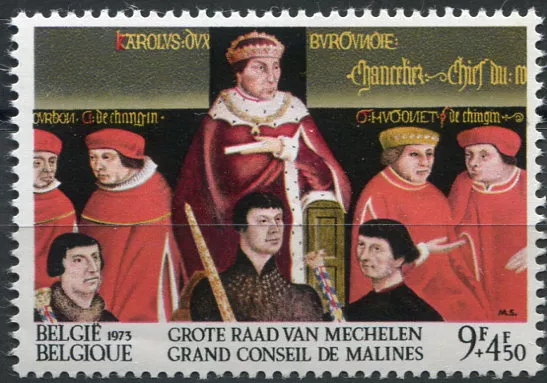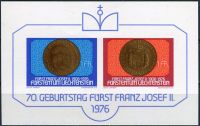- Home
- Philately: postage stamps
- Philately: stamps all over the world
- Europe
- Belgium
- marks **/*
- (1973) MiNr. 1733 ** - Belgium - Grand Council of Mechelen
(1973) MiNr. 1733 ** - Belgium - Grand Council of Mechelen, detail of a painting by Coessaert (15th century)
Belgium - postage stamps

| Code: | BG-1733 |
| Producer: | Belgie |
| Price: | 0,35 EUR |
| Availability: | Sold out - do not order! |
| Stock: | 0 Pcs |
| Year: | 1973 |
| Condition: | ** |
| Catalogue no. (MICHEL): | 1733 |
| Cat. number (St. Gibbons): | 2317 |
| Cat. number (Yvert et Tellier): | 1673 |
The Great Council of Mechelen - the power centre of Dutch justice during the Renaissance
The Great Council of Mechelen (French Grand Conseil de Malines, Dutch Grote Raad van Mechelen) was the highest judicial instance in the Burgundian and later Habsburg Netherlands. Its importance in European judicial history is considerable, as it represented one of the first attempts at central judicial authority in a fragmented set of provinces and cities.
The institution was created in 1473 by the decision of Charles the Bold, Duke of Burgundy. The original idea was to create a unified and superior judicial network that would unify legal practice across the duchy. After Charles's death, the council ceased to exist, but was re-established in 1504 by Maximilian I and subsequently strengthened by his grandson Charles V, who made Mechelen the permanent seat of the institution.
The court decided questions of supreme law, acted as an appellate body, and dealt with both civil and criminal matters. The members of the council were experienced lawyers - mostly trained at the universities of Leuven, Paris or Orléans. Their emphasis was on written evidence, legal precedents and Roman law, which was experiencing a renaissance at the time.
Jan Gossaert, also known as Mabuse, depicted the council at the moment of its ceremonial meeting. Gossaert was an important figure in the early Dutch Renaissance - he travelled to Italy, where he drew inspiration from classical forms, and carried this experience into his works for the Burgundian and Habsburg courts. Not only is his precise depiction of the members he portrayed evident in his paintings, but also his attention to detailed architecture and the symbolic significance of the setting.
The council was based in Mechelen for practical and strategic reasons - the city was an important administrative centre at the time and was geographically located between important provinces such as Brabant and Flanders. This court survived until the end of the 18th century, when it was abolished during the French Revolution and the subsequent reorganisation of the judiciary.
The Grand Council of Mechelen is now seen as one of the forerunners of modern supreme courts. Gossaert's painting is not only a work of art but also a document of the power, hierarchy and cultural ambitions of late medieval and early modern Europe.
Frequently Bought Together - (1973) MiNr. 1733 ** - Belgium - Grand Council of Mechelen, detail of a painting by Coessaert (15th century)
From the Same Category - (1973) MiNr. 1733 ** - Belgium - Grand Council of Mechelen, detail of a painting by Coessaert (15th century)
Poland - series of postage stamps Leon Wyczółkowski (1852-1936): painter, graphic artist and chronicler of the Polish soul Leon Wyczółkowski is one of the most important figures of Polish art at the turn of the 19th and 20th centuries. He was ...
Postage stamps
